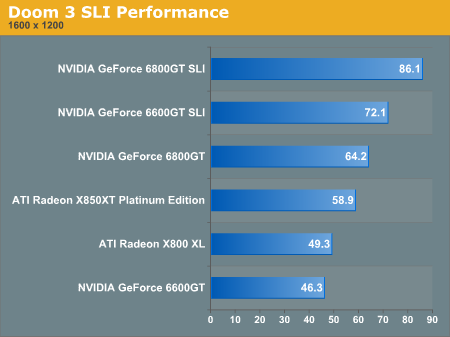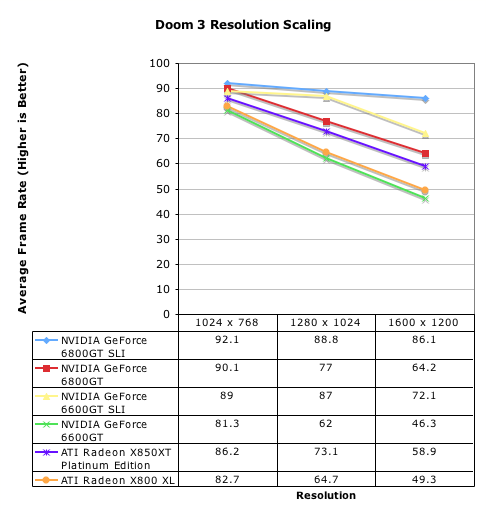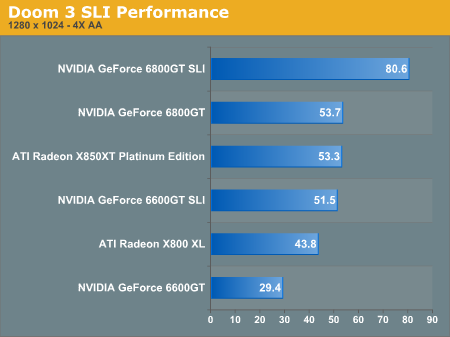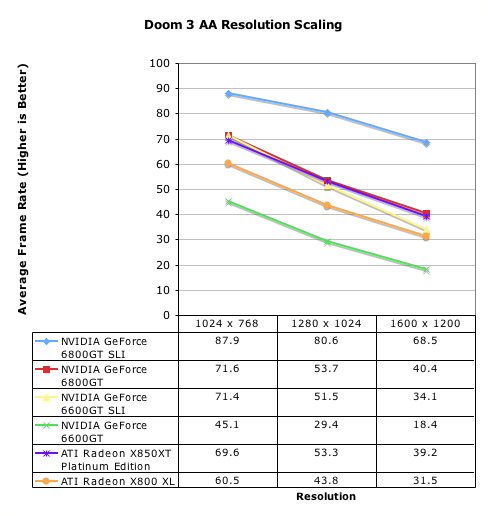Dual Core Intel Platform Shootout - NVIDIA nForce4 vs. Intel 955X
by Anand Lal Shimpi on April 14, 2005 1:01 PM EST- Posted in
- CPUs
SLI Performance
The final performance investigation of this review focuses exclusively on NVIDIA's nForce4 SLI Intel Edition. More specifically, it focuses on SLI performance. The performance benefits of SLI apply just as much to Intel as they do to AMD, but to give you an idea of those performance benefits, we ran tests in Doom 3, Half Life 2 and Splinter Cell: Chaos Theory - three of the most demanding games out today.
Doom 3 Performance
Doom 3 has always been a strong selling point for NVIDIA, and the performance impact of SLI here is extremely strong. At 1600 x 1200, the 6800GT gains 34% from SLI, while the 6600GT gets a nice 56% increase in performance. For Doom 3, a pair of 6600GTs are not only cheaper, but also 22% faster than a single ATI Radeon X850 XT Platinum Edition.


Turning on 4X AA results in even larger performance gains, with the 6800GT getting anywhere from a 23% up to a 70% increase in performance. The 6600GTs fall between 58% and 75%, all very impressive gains as you would expect from a doubling of the number of GPUs in the system.












96 Comments
View All Comments
mkruer - Thursday, April 14, 2005 - link
The only reason why Intel allowed Nvidia to make a chipset for them was for the SLI. Intel is worried, and rightfuly so that Nvidia's SLI sloution for AMD whould give AMD an advantage.Questar - Thursday, April 14, 2005 - link
"Honestly, Intel processors and even the platform haven’t been interesting since the introduction of Prescott. They have been too hot and poor performers, not to mention that the latest Intel platforms forced a transition to technologies that basically offered no performance benefits (DDR2, PCI Express)."Your opinion only, don't make this out to be fact.
"at the end of the day, Intel would still be happier if there was no threat from companies like NVIDIA"
nVidia (please print it correctly) is not a "threat" to Intel in the chipset market. They couldn't make a P4 chipset without a license from Intel. If Intel was threatened by them they wouldn't sell them a license. The purpose in licensing is give system builders more choice in design features.
"However Intel’s chipset team has reason to worry; motherboard manufacturers weren’t happy with the 925/915 chipsets, and with a viable alternative in NVIDIA, we may very well have an opportunity for NVIDIA to start eating into Intel’s own chipset market share in a way that no other company has in the past"
Intel probably makes as much net profit off the licensing of the nVidia chipset as they do selling thier own - after all thay don't have to design, build, ship or sell anything. So why would they be worried?
Really Anand, you have to begin thinking these things trough.
Houdani - Thursday, April 14, 2005 - link
Grrr, I should have noted that I was referring to the NCQ testing.Houdani - Thursday, April 14, 2005 - link
Anand: For the Intel DC Preview, what would you say was the queue depth during the various multitasking tests? I'm curious how today's test compares with how you tested the Intel DC in the preview.Also, is the relation between a depth of 8 versus a depth of 32 linear? Would there be any value in testing a depth somewhere in the middle, such as 16 and/or 24?
Thanks yet again for the quality work!
ChineseDemocracyGNR - Thursday, April 14, 2005 - link
"NVIDIA does not support Intel’s HD Audio spec, so you’re stuck with AC’97 on the nForce4 SLI. "That's inexcusable for a $80 chipset, IMO.
ksherman - Thursday, April 14, 2005 - link
cool and all, but is there any variation of the Intel-based SLI vs the AMD Based SLI?